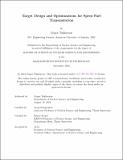Target Design and Optimizations for Spent Fuel Transmutation
Author(s)
Tukharyan, Grigor
DownloadThesis PDF (2.320Mb)
Advisor
Danagoulian, Areg
Forget, Benoit
Terms of use
Metadata
Show full item recordAbstract
There are six long-lived fission products (LLFPs) identified in nuclear spent fuel, which account for at least 99% of the long-term radiotoxicity once actinide recycling is completed. This thesis examines the feasibility of using proton beams to transmute LLFPs into shorterlived or stable isotopes. While long-term storage for high-level waste would still be necessary, transmuting the LLFPs can reduce the volume of waste material that needs to be stored. The objectives of this research are to explore the design of a proton transmutation facility, as well as to determine the optimal LLFP target-blanket material configuration for maximizing the transmutation efficiency. This thesis analyzes the use of intermediate energy beams of 18-70 MeV from commercial cyclotrons for transmutation. This thesis also analyzes the use of 1000 MeV proton beams to generate a substantial number of secondary neutrons through spallation interactions with target materials. The secondary neutrons produced from the spallation process are utilized by the LLFP materials, while surrounding blanket materials are selected to enhance the transmutation efficiency. PHITS, a Monte Carlo transport code, is employed to computationally model the interactions between LLFP materials and the proton beam. In this thesis, PHITS is used to estimate the flux-energy spectrum and the number of atoms irradiated in the LLFP target during beam interaction. This data is then post-processed using a 0-dimensional analysis in FISPACT to estimate the transmutation rate for each LLFP. PHITS is also used to find the depletion rate of the LLFPs for the 18-70 MeV beam case and for spallation-induced transmutations in the 1000 MeV case. Geant4, a Monte Carlo transport toolkit, is used to calculate the production rate of particles attributed to the spallation process. Analysis of the performance of commercial cyclotrons with energies of 18-70 MeV indicates that transmutation rates increase with higher proton beam energy. A cyclotron with a beam current of 10 mA and beam energy of 70 MeV running continuously can transmute 15.401 ± 0.069 g/year of Tc-99. However, Tc-99 is produced at a rate of approximately 8.54 kg/year in a 1 GW reactor, suggesting that a single commercial cyclotron beam is currently not viable for transmutation purposes. A proposed tank design with a lead/Tc-99 target that is surrounded by LLFP pins and heavy water is considered for the spallation study. Although using Tc-99 as a target directly transmutes 0.893 ± 0.002 kg/year from transmutation attributed to spallation, using lead as a target instead approximately doubles the transmutation rates in the LLFP regions for almost all of the LLFP isotopes. In both cases, the depletion rate of the LLFPs is greatly increased compared to using a commercial cyclotron of 70 MeV. A proton spallation source 3 with a beam current of 10 mA and beam energy of 1000 MeV, using a Tc-99 target, achieves a transmutation rate of approximately 10.9 kg/year of Tc-99 in the LLFP pins through secondary neutrons produced by the spallation process. In contrast, using a lead target achieves a higher transmutation rate of around 20.0 kg/year of Tc-99 in the LLFP pins. This work was supported by the DOE ARPA-E Project under the award number DEAR0001578.
Date issued
2024-09Department
Massachusetts Institute of Technology. Department of Nuclear Science and EngineeringPublisher
Massachusetts Institute of Technology